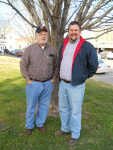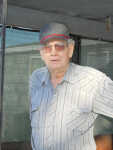Railroaders review unique industry

By James R. Campbell
Nevada Daily Mail
Have you ever watched a freight train come rumbling by and wondered what it's like to work for a railroad company?

Edwin Tourtillot, of Nevada, Daniel Nichols, of Moundville, and Hugh Logan, of Sheldon, can tell you just about everything there is to know because they have tons of experience as switchmen, brakemen, conductors and engineers.
Using a lingo that only "railroaders" understand, they tell of the early years of collecting boxcars loaded with wheat and corn from rural grain elevators and stepping lively to couple boxcars, put trains together and avoid cars slamming together.
Ed Tourtillot
Tourtillot, 62, started with the St. Louis-San Francisco, or "Frisco," Railway and worked through mergers with Burlington Northern and Santa Fe Railway. "I lived at Rich Hill and drove back and forth to Kansas City, starting as a switchman and brakeman," he said.
"I worked my last 12 years as an engineer, running from Kansas City to Springfield, Lincoln, Neb., and Fort Scott. Before that, I was a conductor for about 10 years. The conductor and engineer have equal responsibility. The conductor does the paperwork and the engineer runs the train."
Tourtillot explained that a switchman and brakeman "are about the same thing," switching and coupling cars in a part of the yard called "the bowl," where connections are made to 70 different tracks in Kansas City.
"It's really not that complicated if you mind what you're doing," he said. "You've got to be careful where you walk because you have cars coming right behind you or in front of you in the middle of the night.
"I made a pretty good living. The worst thing is that you're gone for 24 to 32 hours and back home for eight hours. Most people can't imagine what it's like to be on call 24 hours a day. It's not fun."
Tourtillot said the bowl is an area "shaped like a bowl where the cars roll in and settle in the middle so they don't go out the other end.
"The hump is a big hill where the cars shove up," he said. "It is dangerous. I knew several men who were injured. One guy went under the cowcatcher on the front of a train, with 12 inches' clearance. I thought he was dead. He lived but never worked again.
"I had another friend, an engineer who went back to the ground and became a switchman. He was shoving cars to make a joint. When he got through, he was walking on the next track and some cars came on top of him. He was knocked clear, but he had a back injury and didn't work anymore."
Dan Nichols
Nichols came to railroading in a round-about way, attending school in Bronaugh, being homeschooled and graduating from the Heritage Academy in Dallas, Texas, before working as an electrician in Joplin for 14 years. He graduated from the National Academy of Railroad Sciences at Johnson County Community College in Kansas City and joined Kansas City Southern Railway in 2009.
"I drive from my house to Pittsburg, Kan., where we put together one train a day to pick up freight at the outlying stations and take the south route or go to Kansas City," said Nichols, 37, a certified engineer who is working as a conductor pending reassignment. "Kansas City is all yard. There are no road crews out of there.
"This has been a weird year with a lot of accidents, although Kansas City Southern has had no fatalities since the 1990s. There were 12 to 14 in 2012 industry-wide. Most of the time, it's from becoming too comfortable, getting to where you're not paying attention to what you should be doing."
An analysis of each accident is distributed to all the employees of each company. "There was a switchman shoving cars in Indiana who was crushed between cars," Nichols said. "It takes a mile to stop going 55 mph because the average locomotive weighs 400,000 to 425,000 pounds and you have 17,000 pounds of coal in each car."
Hugh Logan
Logan, 78, started for Missouri Pacific Railroad and continued as a brakeman and switchman when that company merged with Union Pacific. Nevada was a terminal back then, constructing and sending trains to Kansas City and Joplin, but those responsibilities were moved to Carthage, he said.
"I had worked as a yard clerk in Batesville, Ark., and we had a friend who was an insurance agent in Nevada who said they were hiring brakemen," he said. "I worked in Nevada during wheat harvest and worked in Webb City and Joplin. "It can be dangerous if you've never been around it. We'd get new hires who didn't understand it at all. You're out in the weather and you need plenty of clothes if it's snowing or raining.
"Years and years ago, a girl got killed north of Jasper when she drove into the second engine. We walked the track a half-mile each way before we found her. She died at the hospital. The lights were on and the whistle was blowing. I don't know if she was not paying attention or what."
Asked how the business has changed, Logan said train companies were more closely involved in agricultural harvests in the old days. "Every little town had an elevator and filled two or three or four or five boxcars with wheat, soybeans, corn or prairie hay," he said.
"My legs are worn out now from jumping on and off those cars."
